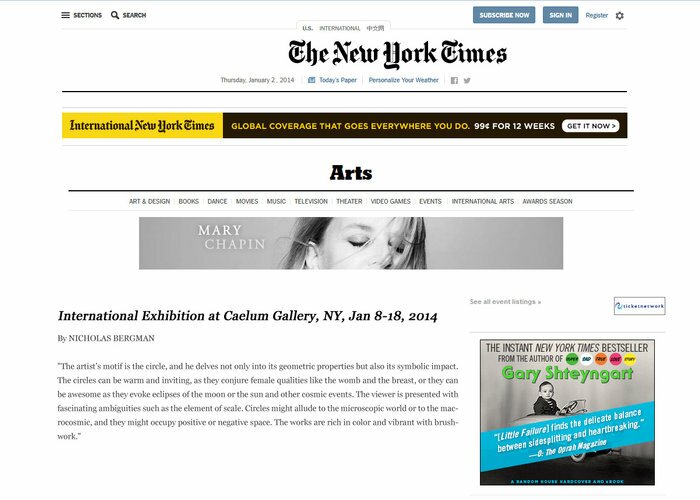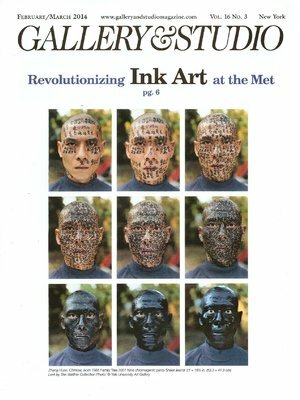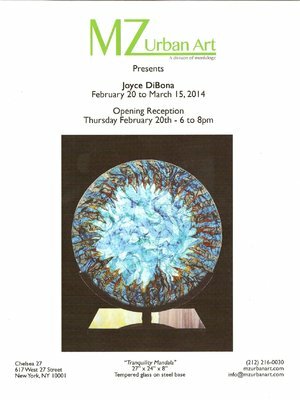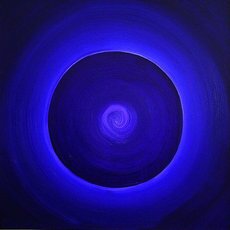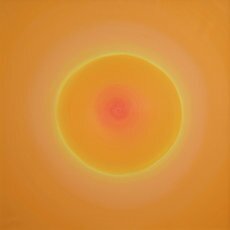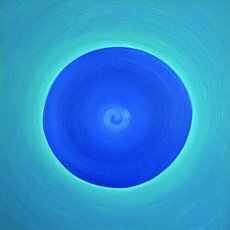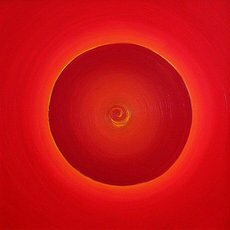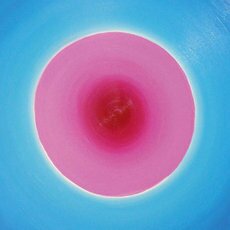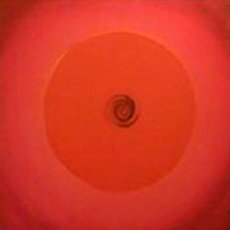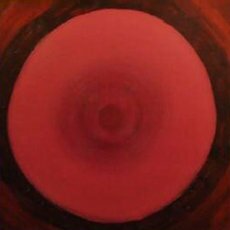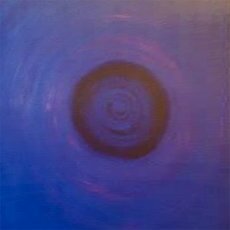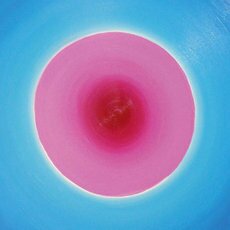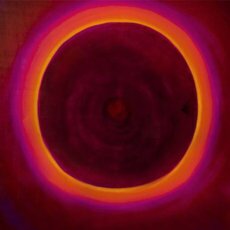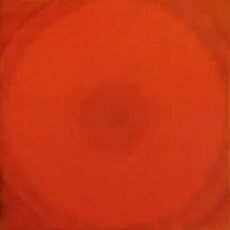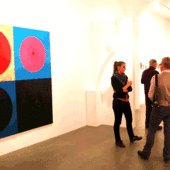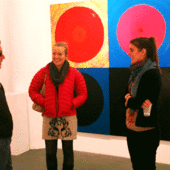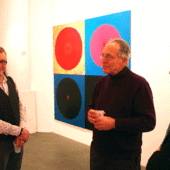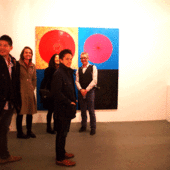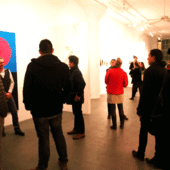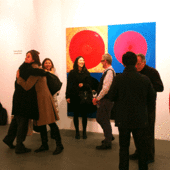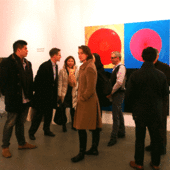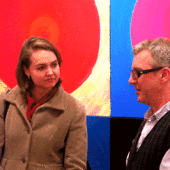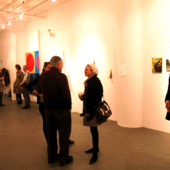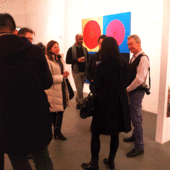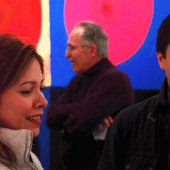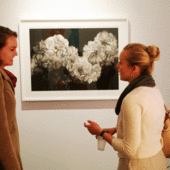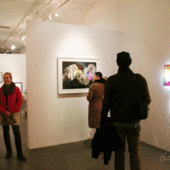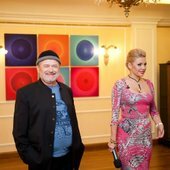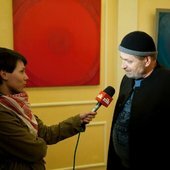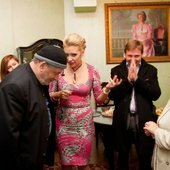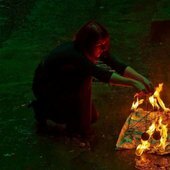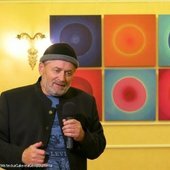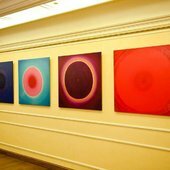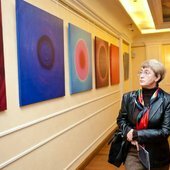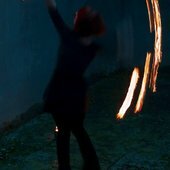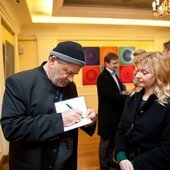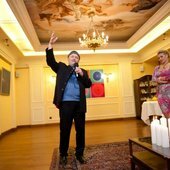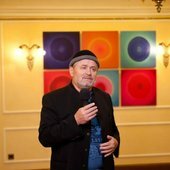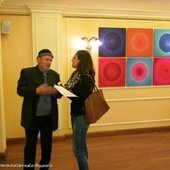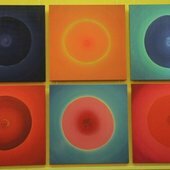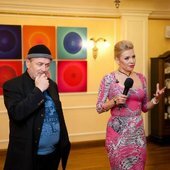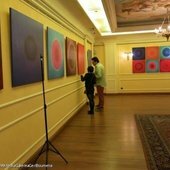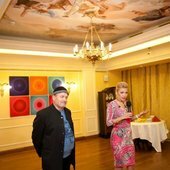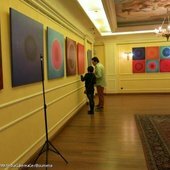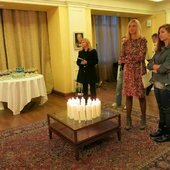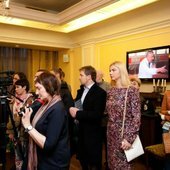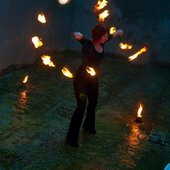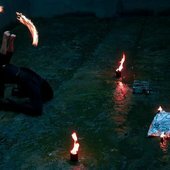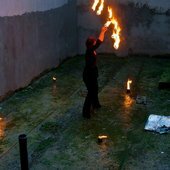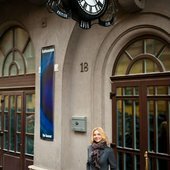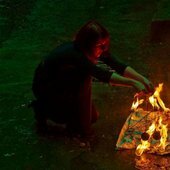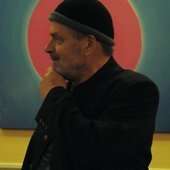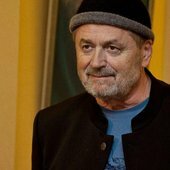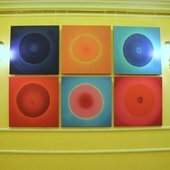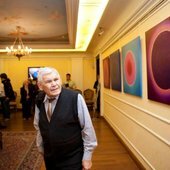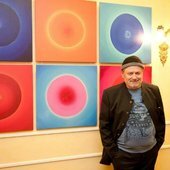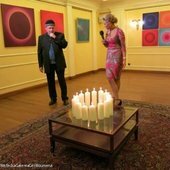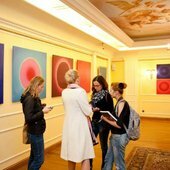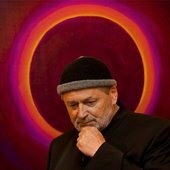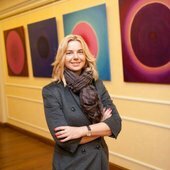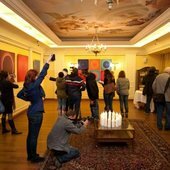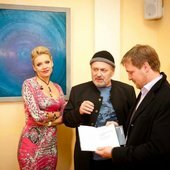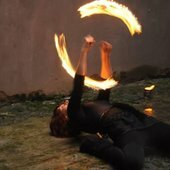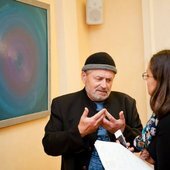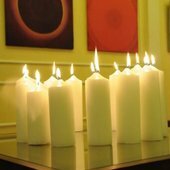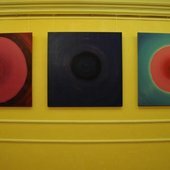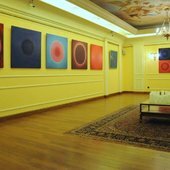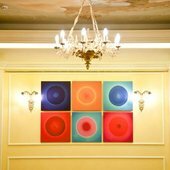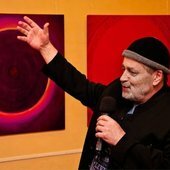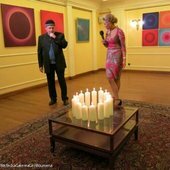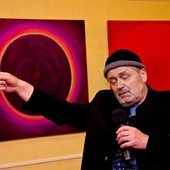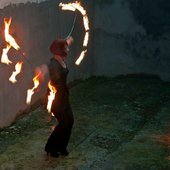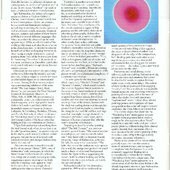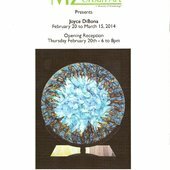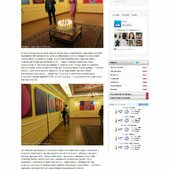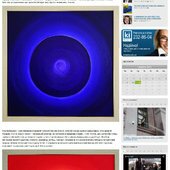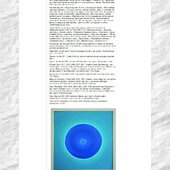new york "wandering stars" project
Representation: RAR Gallery, Berlin
Wikipedia
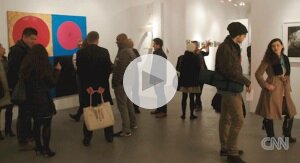
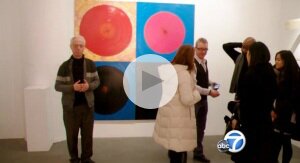
Oil, canvas
6 canvases: 60cm x 60cm (1,97 x 1,97 feet), 2013
Oil, canvas
6 canvases: 100cm x 100cm (3,28 x 3,28 feet), 2013
Photos from the Show in New York:
The art show "Sacred" in the Gary Boumen Gallery, British Club, Lviv:
reviews
"The artist’s motif is the circle, and he delves not only into its geometric properties but also its symbolic impact. The circles can be warm and inviting, as they conjure female qualities like the womb and the breast, or they can be awesome as they evoke eclipses of the moon or the sun and other cosmic events. The viewer is presented with fascinating ambiguities such as the element of scale. Circles might allude to the microscopic world or to the macrocosmic, and they might occupy positive or negative space. The works are rich in color and vibrant with brushwork."
Curatorial Review for The New York Times, Nicholas Bergman,
international Exhibition at Caelum Gallery, NY, Jan 8-18, 2014
"As I walked in, I couldn't help but notice massive spherical shapes dominating the wall, and the gallery overall, so it seemed. Titled "The City - New York" from the series "The Wondering Stars", four large paintings form one big wall-size square, a collage of spheres which engulfs the viewer, mesmerizes him and bewitches with its rigid conceptual sensuality of form. "The 2014 international Winter Exhibit" in Caelum Gallery in Chelsea - represented this time, much more then just the art show, it stood for the contemporary movement and concept in the New York Art Scene of the 2013 overall. It became a summary of the 2013 and its top art trends: the ideas, the concepts, the elements, the vision of the year - were all here.

Somehow, I was not a bit surprised to see the so called "renaissance man" - Igor Kalinauskas (an European artist, author of "The City - New York" from the series "The Wondering Stars" displayed in the show), turn to "tondo" art shapes in his painting. These round, circular shapes known to art critics as "tondo" (an Italian word for "round"), have their deep historical roots. It was the most common shape in use by the Renaissance masters, specially when depicting divinity and the sacred. Thus, the parallel between the the earlier works by Kalinauskas, such as "The Last Supper" installation, and the new tondo paintings is remarkable. It is a natural continuation of the sacred theme, the divine and the worshiped. Yet now, Kalinauskas translated the objects into paint, the installation into the basic abstract shapes, that are both: rich in historical value and background, and yet absolutely modern in context.
One may argue, that the hight of the contemporary "tondo movement" took place in early sixties and seventies, with works by such artists as Wojciech Fangor and his non-tantric disc-like paintings. This theme was later continued in a series of works by Lea Lenhart. While some artists such as Robert Schaberl, Hans Herbert Hartwieg, also Gary Lang and Tracy Melton still continue to work in the Tondo movement today.

Yet I do not see Igor Kalinauskas' work as the remains of the 60s and 70s movement, that some how survived or is being continued up until now. On contrary, I see it as a totally new wave of Tondo, which underwent the renaissance of its own principal ideals and is now a thriving, totally new, post modern form of expression.
Just recently in 2013, this divinely inspired circular shape was glorified in the new New York exhibit, at the "Shore Institute of the Contemporary Arts". This incredible tribute to the modern renaissance of the eternal Tondo Movement, was carefully selected and paced together by the curators Christian Vassallo and Matthew Fisher. And what strikes the viewer, are not just the sensual eternal round shapes, but the young age of their creators. No, it's not the residue of the 60s and 70s anymore. It's a brand new movement in contemporary art, led by the young artists such as: Jim Houser, John Phillips, Andrew Masullo, Francis Holstrom and Luis Cameron, to name a few. Their painting and graphics form the art of pure pleasure.
I also can draw a clear parallel between Kalinauskas' affinity for the Man and the subjective being, and the circular shape as a concept. Once again, we have to turn to history. While the round shape was used for divine depiction during Renaissance, later, it became a staple form used for the civic portraiture. These shapes, titled "Wondering Stars" combine two primordial concepts - that of the divine and that of the subjective. They are on their own right, nothing else but the "divine portraits" in the contemporary context and society.
It is no secret, that the circular format is truly innate and pleasing. It seduces the viewer with its sensuality of form and pleases the eye with its eternal planetary shape, that is subsequently - identical to the shape of the human eye, its iris and lens. Our eye does not react in the same way to the shape on a square or a rectangle, not physically, not mentally and not psychologically. It is the circle alone, that is the most sensual of shapes. Feminine in its form and nature, the Tondo seemingly takes over the viewer.
A yet, Igor Kalinauskas took the Tondo form even further. He toys with the idea of the feminine within the masculine, the circle within the square. It is a simple and elegant concept, that represents philosophical ideals of the "ing and yang", the everything and the nothing, the eternity in one instant. The universe overall and the universe within each man. These ever fluid eternal tondo shapes locked within a stable square - are nothing more, then the contemporary "every man" portraits. These are the two aspects, two shapes that are present in each individual, in his psyche, in his ming and in his body, be it a woman or a man - we all posses the masculine and the feminine within us. And these elements can wether fight or harmoniously coexist, their interaction defines our individual character, look, form, color, shape, etc. Much like classical civic portraits, they too, show our differences, imperfections, beauty, wrinkles, thin lip or double chin.
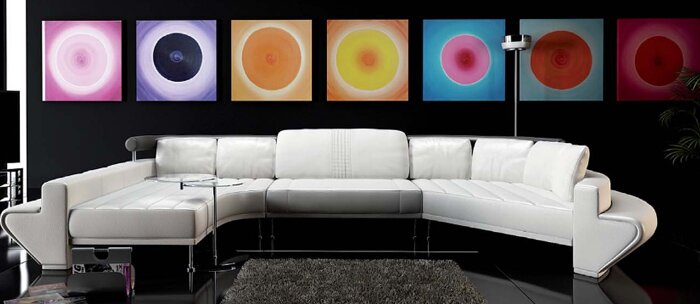
With an anticipation of a child on a Christmas Eve, I look forward to new works by Kalinauskas. I eagerly await new implementations of the Tondo, perhaps further translating them into a three dimensional shapes, and elements of contemporary sculptural design and installation. As it was done by numerous contemporary young artist: Nami Yomamoto in her tondo installation of the "Primordial Soup" (2005), refine and elegant, it can yet be easily taken even further and transferred into larger scale, and even contemporary design forms; or work by Derick Melander, a striking tondo sculptures not of bronze, plaster, clay or wood - but of folded clothing, this questions the issue of consumerism in modern society, global mobility, idealism, identity and affluence; or perhaps even mesmerizing yet kitschy-looking painting by a New Yorker B. Wurtz, painted immediately on the back of the aluminum pans and displayed on the wall almost, as if a frisby ad or new line of car hubcaps. Cheesy-looking or kitschy as they may seem, they too mesmerize the viewer with their bewitching steady radiance.
Kalinauskas already flirted with an idea of light and space installation, by adding the element of light to the tondo shape. These cosmic-like, primordial spheres came even more alive with an addition of light. I look forward to new dimensions, materials and concepts from this, truly, one of a kind artist.
With confidence I can declare that New York of 2013 - was a year of contemporary Tondo Movement in art. Some may call it a "come back of the 70's concept", while I say - it is a much needed and awaited breath of fresh air in the cities art scene. It began with the a contemporary tondo exhibit in the "Shore Institute of the Contemporary Arts" and it was concluded with the winter exhibit of Igor Kalinauskas in the Caelum Galley in Chelea."
Christina Katrakis MFA (PhD), contemporary international art critic and curator, art historian,
professor of Fine Arts and Art History, president of the International Academy of Arts,
UN ambassador of good will in the field of Culture, USA.
"WANDERING STARS" OF IGOR KALINAUSKAS
Igor Kalinauskas' works display in Zurich from August 17 till August 21 (2011).
A minor vernissage of a Russian artist Igor Kalinauskas has closed in Zurich this week. Its opening in a small gallery in the heart of the old town, lost in the labyrinth of ancient houses, making it even more intimate, gathered – as the organisers stated – about a hundred visitors. They all had come to enjoy the works of the author – the brush and voice masterpieces. It is hard to imagine them housed in this two-storey building, but the reason for them to be here is clear to anyone, who has seen the master's works.
I see people in the street from afar, approaching the gallery. They are in their evening wear, holding glasses of champagne. They speak different languages – English, German, French, Russian – discussing one and the same thing: "wandering stars" of Igor Kalinauskas.
Such was the title, given to this personal exhibition of the artist, where he presented his nine works, canvases, carefully painted circles. His pictures leave the audience cold-minded only at a distance. His "wandering stars" are piercing comets, getting into your heart and leaving their splinters – flashes of emotion – in your soul.
They are multifaceted and versatile. They talk to you in their own "silent language", making you lose track of time. They cloak you in their energy and conciliation. Standing in front of them like at a confession leaves your mind blank but for the only question, "How can I put into words the feeling, born within myself at the sight of Igor Kalinauskas' pictures?" This feeling is eternity, made not just of brushes and paints, but also of the multitude of personalities, combined in one and the same person.
Kalinauskas – Silin – Nikolaev
The virtual acquaintance with the author during the interview and its preparation long before the exhibition itself allowed me to get to know the author in person, putting in words all my thoughts of him. I meet the master in the veranda – modest, wearing a vest and a cap, he is smiling to everyone. His look is cordial and positive. His voice is calm, joyful and filled with the love of life, here and now. There he is – the person, combining a number of professions and stage-names, the master, showing the world to his "stars".
Igor Kalinauskas is a master of moral tradition, the leader and one of the participants of "Zikr" vocal duo, an artist, poet, stage director, philosopher, practising psychologist, member of "Management, information technologies and communications in the society and nature" UNESCO International Academy, honoured president of the International Academy of Science and Culture, full member of International Informatization Academy, holding PhD in psychology and socionics, the author of numerous books and a very attractive person. He mirrors his pictures and they mirror him.
What did it all come to? What was the outcome?
"They have a rather strange story – my stars – they are living a life of their own. I saw them, started painting and left standing in my studio for nearly three years. We went to exhibitions and vernissages, but the pictures were not taken, they stayed with me. And then all of a sudden they were sold out – all at a time. I called them "space embryos", but the exhibition managers decided they needed a more harmonious name – so they became "wandering stars". But to tell you the truth – it is music. The music of our "Zikr" duo (Igor is a poet and a composer in the vocal improvisation duo, known under the stage name of Silin – E.J.), where I work with Olga Tkachenko, expressed in painting. Just imagine a certain laser "reader" able to read their music – they are real records!" I look at the pictures and in fact – their edges are rough, clearly marking the borders, and there are tracks round the circle. Just take them and play!
But how did the pictures get their present look?
"I have already had series. I used to paint smells – the smell of coffee, for example," Igor goes on with his story, "I used to exhibit my pictures in the centre of Rolan Bykov, Moscow. But then I understood that it is not smells I should paint. I should paint music, reflecting our gift. We have been singing for 18 years already, with 22 studio disks recorded. We should put our voice theatre on canvas. I tried it – and it came out well. And I am really happy about it".
Could you say a couple of words about yourself, please? What kind of a person are you? Your stage-names or characters – Nikolaev and Silin – are they your "self"? Why do you need so many last names?
I see myself alive, clever, strong and kind. I try to feel and see rather than reason. I am doing my best not to lose the relish for life. And, I believe, I get much more. As for my stage-names – it's a rather long and confusing story. Once I had to change my last name for the sake of my son – that was because of certain difficulties with the Soviet authorities. I also have a stage-name Silin – that is my mother's last name. I use this stage-name to perform free vocal compositions with Olga Tkachenko, my "Duo Zikr" partner.
Three last names are three personalities. Kalinauskas is an expert in constructive psychology, consulting, holding workshops, writing books – in a nutshell, a scientist. Silin is a singer, extemporizer, employing Kalinauskas' "Fire flower" technique for the music of states. Nikolaev is a stage director. As for the artist's personality – I identify it as INK. They are all one and indivisible in their pursuit of revealing the eternity of a human soul.
You have launched a number of projects. Which of them are your favourites and why?
I have three favourite "children". Naturally, they are painting, singing and practical psychology. Each of them is my inner world facet, helping me tell people about their magnificence. I'm trying to tell my audience, "Discover your greatness and versatility, do not be afraid to cross the border of being as such". As they used to say in older times, "Those who are scared are imperfect in love". Like any artist, I would like to reveal the eternity of a human soul, its colours, space and powers in my works and put it on canvas.
You are in permanent search. You have tried your potential in a number of spheres and have even more in mind. What are you looking for in life and art? What have you already found?
I search for and sometimes find the life of human spirit. I am trying to feel and see it and the way it shows in people's lives. I see myself as a person striving to fulfil himself in all aspects of his existence. I am trying to be in resonance with the reality and show what this state leads me to. Now I'm going to try myself as a photography artist.
When you are with Igor Kalinauskas, time just flies by. We are talking about everything that comes to our mind and the words snow. His eyes are shining and his voice sounds like that of a real story-teller, whose words are hard to turn away from. I believe it is always like that with people who put their heart and soul into whatever they do. In this case the outcome is also worth sharing. Igor shares his pictures, books, plays and lectures. He shares his smile and the unbelievable feeling of happiness, as light as air and dissolved in it. He gives away his pictures, letting his stars go. God-speed to them!
Elena Jetpyspaeva, art reporter, "Nasha Gazeta"
“A truly contemporary and "mytho-poetic" concept was presented to the viewer in the British Club building, part of Gary Bowman Gallery, Lviv. Why here, in this "petit pale", in this old traditional space, filled with baroque murals and frescoes? On one hand, the viewer is surrounded by the rigid portraits of the queen and the king, floating rococo figures on the sealing frescoes, yet on the other hand, he views astonishingly abstract conceptual painting on the walls. One can't help, but feel a certain disconnect, perhaps a shock and awe, and even be taken aback with this unconventional approach. Yet combining old and new, marrying them into one unanimous - is at the grounds of post modernism itself. And Igor Kalinauskas is a known master of this game. Be it his presentation of "The Last Supper" installation, poignantly placed within the sacred space of the cathedral, or these series of "Wondering Stars" playfully displayed, as if by an accident, on the walls on an old palatial structure - it is always a dramatic play of the eternal. The element of performance is indeed omnipresent. The show opened with a dance of fire, where a dancer herself created abstract circular shapes with ope flame. These very shapes, were then echoed with the paintings of the "burning spheres" at the show, titled "Wondering Stars". One can not help, but be reminded of the Shalom Aleichem's novel - "Wondering Stars", and feel the social and philosophical tension of this creative prototype. As if the artist himself is working in collaboration with this literary master. These parallel's with Aleichem's work, define the space itself and undermine the whole concept of the social order, and the "political correct". Once again, the "il directore" - Kalinauskas, much like Fellini, has engaged the viewer in the play. No, not as an aloof spectator but rather as an actor, an active participant instead.”
Christina Katrakis MFA (PhD), contemporary international art critic and curator, art historian,
professor of Fine Arts and Art History, president of the International Academy of Arts,
UN ambassador of good will in the field of Culture, USA.
Igor Kalinauskas: A Russian Artistic Cosmonaut Takes Off
 In his his iconoclastic essay "Asphysixiating Culture," the French painter Jean Dubuffet laments the influence of culture on contemporary art, in favor of "outsider art," or to use his own term, "Art Brut": the work of naive, unschooled artists or mental patients.
In his his iconoclastic essay "Asphysixiating Culture," the French painter Jean Dubuffet laments the influence of culture on contemporary art, in favor of "outsider art," or to use his own term, "Art Brut": the work of naive, unschooled artists or mental patients.
Igor Kalinauskas, the subject of a superb recent exhibition at Caelum Gallery in Chelsea, is neither naive or unschooled; nor is he a mental patient. Quite the contrary, he is a renowned Russian psychologist specializing in studying the creative process as well as a business coach, musician, theatrical director, lecturer, and author of thirty books published in several different languages. But when, at a relatively advanced age he took up painting in 1996, as a direct result of his working with visual and other kinds of artists in his clinical practice, he decided to educate himself rather than undergoing formal study After taking a couple of lessons in classical painting from "one of the best teachers from St. Petersburg," he arrived independently at the same conclusion as Dubuffet: that further study could only serve to asphyixiate his own creative process.
Obviously, he was correct; for proceeding on his own, following his intuitive aesthetic instincts, he has emerged in a mere few years as a formidable figure in the international art scene. Among his best known projects was a newsmaking exhibition of his series of oils "The Last Supper: Spirit, Flesh, Blood," at the Leonardo Da Vinci National Science 8c Technology Museum, in Milan, Italy, in 2006. He also presented a multimedia project, in collaboration with Bond magazine, at the high-profile Saachi Gallery in London; and had exhibitions in similarly esteemed venues in Moscow, Lithuania, St Petersburg, Bratislava, Ukraine, and Zurich, Switzerland, where he debuted his "Wandering Stars" series of paintings at ArtConcept Gallery. (The latter series that highlighted his solo exhibition in Chelsea.)
If Igor Kalinauskas learned anything from his brief formal study of art, it was that what he calls "good loneliness," or creative solitude in the studio, could not only enhance artistic progress, but put the artist in touch with spiritual resources and energies hidden deep inside his inner self.
This concept seems to manifest visually in the oil on canvas "Alone," 2001, one of Kalinauskas' early landscapes, in which the branches and verdant leaves of a solitary tree, rising out of closely packed gray rocks, suggesting a quarry interrupted on both sides by a winding road, appear to bend in the same direction as a single cloud drifting in the blue sky above. Painted in a straightforward descriptive manner akin to that of Rene Magritte, but sans that famous Belgian surrealist's manipulation of obvious incongruities, Kalinauskas' "Alone" appears strikingly symbolic of creative transcendence.
Portraiture is another area in which Kalinauskas makes a rich contribution to contemporary painting. Superficially, his portraits, with their areas of flat, unmodulated color devoid of traditional modeling or shadow, as well as the impassive expressions of his sitters, can resemble those of Alex Katz. But where Katz is influenced by the two-dimensional imagery of Pop painting and the airbrushed slickness of advertising photography, Kalinauskas looks to the almost primitive simplicity of Russian icons for inspiration. In other words, Katz seeks a deliberate "emptiness," in its own Way not unlike Warhol's emotionless vacuums, Kalinauskas endeavors to make his simplified likenesses mirror his subjects' souls, the very "energy core" of their individual personalities. Thus, while at first glance, with her off-white veil half covering her red hair, as she bathes the viewer in her clear blue gaze, "Barbara's Portrait" may resemble a Byzantine painting of a saint, yet prolonged contemplation of the picture reveals the sophisticated complexity of a contemporary woman.
The same goes for the two male subjects titled, respectively, "Martin's Portrait" and "Roman's Portrait," which could resemble 2nd century Egyptian funeral portraits in the ancient wax-based medium of encaustic. But look closely at Martin, with his close cropped Jean Genet haircut, five o'clock shadow, and eyes that veer sideways to avoid meeting those of the viewer; Roman with his black hair curling down over his ears, his pointed beard and mustache surrounding his triangular face and full red lips, and large eyes that bore right through those of the onlooker; and notice, once again, subtle nuances of human character that belie the artist's simplicity of technique.
Preparing to describe another painting titled "The Self-Portrait," one previous reviewer quoted Bunin: "The soul of another is a dark place, our own is a much darker one." But, faced with the bearded, bearish yet genial, visage of Kalinauskas, as he sees himself, the same writer concluded: "The light blue eyes of the author are wide open to the world, the orange (not golden!—it could imply a shade of sainthood) background frames the figure without suppressing the viewer. As if the artist is looking out of the window into the street, towards the world, the sun and people."
Kalinauskas called his first abstraction, painted in 1999 in oil on cardboard (as though scrimping on materials for fear of wasting a good canvas on an experiment that could possibly meet with abject failure!) "Window To The Other World." But this simple pairing of two embryonic shapes — one an oval resembling a blue eggplant, the other a vibrant ribbon of yellow that disappears off the edge of the composition, both floating quite near each other at the top of die picture space in a visceral red environment that could suggest the interior of the womb — did indeed open a new world of discovery for die artist.
Numerous arid varied abstract works followed, each one enabling Kalinauskas to dig deeper into ideas and emotions that cannot be described in words, to express his inner reality more vividly, more deeply. The earliest of these works are possessed of an engaging "crudity," as if this autodidactic but intuitively brilliant neophyte were inventing nonobjective painting all over again, with a freshness of vision that eludes more self-consciously "sophisticated" artists. Indeed, these vibrant paintings possess an intrepidness of vision comparable to that other self-taught visionary modernist, die Texas fisherman Forrest Bess.
The circular shapes that dominate the "Wandering Stars" series appear in more tentative form as gestural linear swirls in single earlier abstractions such as "Soul," solidify here into full circles and gain a more precise presence without losing their ethereal quality. Indeed, their numinous effect is now enhanced by the artist's growing ability to evoke a sense of light through a newly developed chromatic refinement.
Placed at die center of die canvas within perfectly square formats that create a sense of unlimited space, and set against a complementary background hue, each cosmically suggestive floating orb is surrounded by a radiant linear nimbus that bathes it in its own unique aura. The "Wandering Stars" series appears to be a culmination of all that has come before in the already impressive oeuvre of Igor Kalinauskas, whose, artistic trajectory itself suggests a stellar journey.
Byron Coleman, Studio & Gallery, New York Magazine, USA.
Videos:


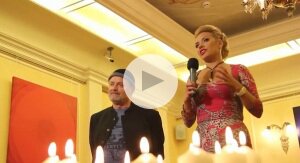
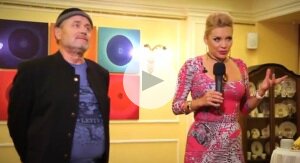

Recent Articles about "Wandering Stars" Project:


